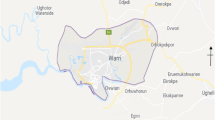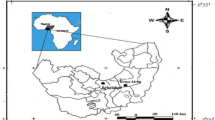Abstract
Bioremediation has become an attractive alternative to physicochemical methods of remediation of polluted sites. White rot fungi (WRF) are increasingly being investigated and used in bioremediation, because of their ability to degrade an extremely diverse range of very persistent or toxic environmental pollutants. The white rot fungus, Pleurotus tuberregium, was examined for its ability to ameliorate crude oil polluted soil. This was inferred from the ability of the polluted soil to support seed germination and seedling growth in Vigna unguiculata, at 0, 7 and 14 days post treatment. Results obtained from the present study showed that bioremediation of soil contaminated with crude oil was possible, especially when the fungus had been allowed to establish and fully colonize the substrate mixed with the soil. There were significant improvements in % germination, plant height and root elongation values of test plants, when seeds were planted 14 days post soil treatment. At 1 to 5% crude oil pollution, % germination values were comparable with the values in control plants in the 14 days treatment, and significantly higher than values obtained in the day 0 treatment. Also, at the highest level of crude oil pollution (15%), there was about 25% improvement in % germination value over the 0 day treatment. This trend of improvement in values was also observed for plant height, root elongation and biomass accumulation as well as decreased total hydrocarbon content.
Similar content being viewed by others
References
Allen-Christopher CR, Boyd-Derek R, Hempenstall F, Larkin M J, Sharma ND (1999): Contrasting effects of a non ionic surfactant on the biotransformation of polycyclic aromatic hydrocarbons to cisdihydrodiol by bacteria. Applied and Environmental Microbiology 65, 1335–1339
Amakiri JO, Onofeghara FA (1984): Effect of crude oil pollution on the germination of Zea mays, Abelmoschus esculentus and Capsicum frutescens. Oil and Petroleum Pollution 35, 159–167
Anoliefo GO, Isikhuemhen OS, Agbuna SO (2001): Small-scale industrial village in Benin City, Nigeria: Establishment, failure and phytotoxicity assessment of soils from the abandoned site. Water Air and Soil Pollution 131, 169–183
Anoliefo GO (1991): Forcados Blend crude oil effects on respiratory metabolism, mineral element composition and growth of Citrullus vulgaris Schrad, PhD thesis, Department of Botany, University of Benin, 293 pp
Anoliefo GO, Vwioko DE (1995): Spent lubricating oil effect on the growth of C. annum L. and L. esculentum Mill., Environmental Pollution 88, 385–388
Anoliefo GO, Isikhuemhen OS, Okolo EC (1999): Traditional coping mechanism and environmental sustainability strategies in Nnewi, Nigeria. J Agriculture and Environmental Ethics 11, 101–109
Costas JD, Bruce RA, Haddock JD (1998): Anoxic bioremediation of hydrocarbons. Nature 396, 730
De Jong E (1980): The effect of crude oil spill on cereals. Environmental Pollution 22, 187–196
De Vos CHR, Schat H, Vooijs R, Ernst WHO (1989): Copper-induced damage to the permeability barrier in roots of Silene cucubalu. J Plant Physiol. 135, 164
Barr DP, Aust SD (1994): Mechanisms white rot use to degrade pollutants. Environ Sci Technol 28, 78–87
Marquez-Rocha FJ, Hernandez-Rodriguez V, Lamela Ma T (2001): Bio-degradation of diesel oil in soil by a microbial consortium. Water, Air and Soil Pollution 128, 313–320
Galli EU, Tomati A, Grappeli A, Buffone R (1988): Recycle of olive oil waste water for Pleurotus mycelium production in submerged culture. Agrochimica 32, 451–455
Hammel KE (1989): Organo-pollutants degradation by lignolytic fungi. Enzyme Microbiol Technol 11, 776–777
Ijah UJJ, Antai SP (1995): The effect of nitrogen and phosphorus supplementation on crude oil degradation by Streptomyces viridosporus T7A. Discovery Innovations 7, 387–390
Kubatova A, Erbanova P Eichlerova I, Homolka L, Nerud F and Sasek V (2001): PCB congener selective biodegradation by the white rot fungus Pleurotus ostreatus in contaminated soil. Chemosphere 43, 207–215
Isikhuemhen OS, Moncalvo J-M, Nerud F, Vilgalys R (2000a): Mating compatibility and phylogeoraphy in Pleurotus tuberregium. Myco-logical Research 104, 732–737
Isikhuemhen OS, Nerud F, Vilgalys R (2000b): Cultivation studies on wild and selected hybrid strains of Pleurotus tuberregium. World journal of microbiology and biotechnology 16, 431–435
Isikhuemhen OS (1999): Studies on an edible tropical white rot fungus Pleurotus tuberregium (Fr.) Sing. Ph.D. thesis. Instituted of Microbiology, AS CR, Prague, 147 pp
Isikhuemhen OS, Nerud F (1999): Preliminary studies on the ligninolytic enzymes produced by the tropical fungus Pleurotus tuberregium Fr. Sing. Anthonie van Leeuwehoek 75, 257–260
Isikhuemhen OS, Okhuoya JA (1996): Cultivation of Pleurotus tuberregium (Fr.) Singer for production of edible Sclerotia on agricultural wastes. Mushroom biology and mushroom products (Royse DJ, ed), Penn. State University, University Park, USA, pp 429–436
Isikhuemhen OS, Okhuoya JA (1995): A low cost technique for the cultivation of Pleurotus tuber-regium (Fr.) Singer in developing tropical countries. Mushroom Growers’ Newsletter 4 (6): 2–4
Lai B, Khanna S (1996): Mineralization of [14C] octacosane by Acinetobacter calcoaceticus S 30. Canadian Journal of Microbiology 42, 1225–1231
Lange E, Nerud F, Zadrazil F (1998): Production of ligninolytic enzymes by Pleurotus sp. and Dichomitus squalens in soil and lignocellulose substrate as influenced by soil microorganisms. FEMS microbiology letters 167, 239–244
Isirimah NO, Zuofa K, Loganathan P (1989): Effect of crude oil on maize performance and soil chemical properties in the humid forest zone of Nigeria. Discovery and Innovation 1, 95–98
Lyle GW, Jalal H, Edward Z, Luc B, William El, Charles WG (1998): Biodegradation of variable-chain-length alkanes at low temperatures by a psychotrophic Rhodococcus sp. Applied and Environmental Microbiology 64, 2578–2584
Malallah G, Afzat M, Gulsham S, Abraham D, Kurian M, Dhami MSI (1996): Vicia faba as a bioindicator of oil pollution. Environmental Pollution 92, 213–217
Nwokolo E (1987): Composition of nutrients in the sclerotium of the mushroom Pleurotus tuber-regium. Plant Foods for Human Nutrition 37, 133–139
Okhuoya JA, Isikhuemhen OS, Evue GA (1998): Pleurotus tuber-regium (Fr.) Sing. Sclerotia and sporophore yield during cultivation on sawdust of different woody plants. The International Journal of Mushroom Sciences 2, 41–46
Okhuoya JA, Etugo JE (1993): Studies of the cultivation of Pleurotus tuber-regium (Fr.) Sing. an edible mushroom. Bioresource Technology 44, 1–3
Okhuoya JA, Okogbo FO (1991): Cultivation of Pleurotus tuberregium (Fr.) Sing. on various farm wastes. Proceedings of Oklahoma Academy of Science 71, 1–3
Onwioduokit EA (1998): An alternative approach to efficient pollution control in Nigeria. In: Current Issues in Nigerian Environment (Osuntokun A, ed) Friedrich Ebert Foundation, Davidson Press, Ibadan
Oso BA (1977): Pleurotus tuber-regium from Nigeria. Mycologia 69, 271–279
Pegler D N (1983): The Genus Lentinus. A world Monograph. Kew Bulletin Additional Series 10. London. Her Majesty’s Stationery Office. ISBN 0-1-242627-1
Tomati U, Galli EU, di Lena G, Buffone R (1991): Induction of laccase in Pleurotus ostreatus mycelium grown in olive mill waste waters. Agrochimica. 35, 275–279.
Van Beelen P, Fleuren-Kemila AK (1989): Enumeration of anaerobic and oligotrophic bacteria in subsoil and sediments. Journal of Contamination Hydrobiology 4, 275
Van Beilen JB, Wubbolts MG, Witholt B (1994): Genetics of alkane oxidation by Pseudomonas oleovorans. Biodegradation 5, 161–171
Zervakis G, Balis C (1996): Bioremediation of olive oil mill wastes through the production of fungal biomass. Mushroom biology and mushroom products (Royse DJ, ed), Penn. State University, University Park, USA, pp 311–323, ISBN 1-883956-01-3
Author information
Authors and Affiliations
Corresponding author
Rights and permissions
About this article
Cite this article
Isikhuemhen, O.S., Anoliefo, G.O. & Oghale, O.I. Bioremediation of crude oil polluted soil by the white rot fungus, Pleurotus tuberregium (Fr.) Sing.. Environ Sci & Pollut Res 10, 108–112 (2003). https://doi.org/10.1065/espr2002.04.114
Received:
Accepted:
Issue Date:
DOI: https://doi.org/10.1065/espr2002.04.114




